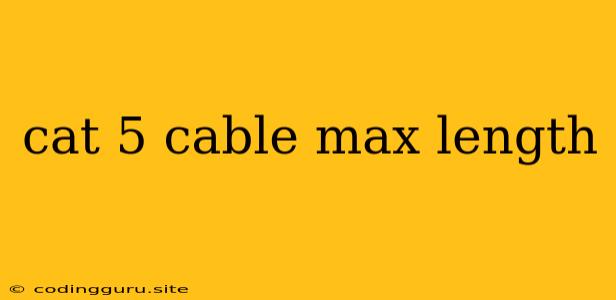Understanding Cat 5 Cable Max Length: A Comprehensive Guide
The ubiquitous Cat 5 cable has become a staple in modern networking, connecting devices like computers, routers, and switches. But have you ever wondered what the maximum length of a Cat 5 cable you can use before encountering performance issues? This guide will delve into the intricacies of Cat 5 cable maximum length, helping you understand its limitations and optimize your network setup.
What is Cat 5 Cable?
Cat 5 cable refers to a twisted-pair cable commonly used for Ethernet connections. It consists of four pairs of twisted wires, each pair carrying data signals. The twisting helps minimize interference and ensure reliable data transmission.
The Importance of Cat 5 Cable Length
The length of your Cat 5 cable plays a crucial role in the performance of your network. Cat 5 cable is designed to handle specific data rates and signal strength over a defined distance. Exceeding the recommended maximum length can lead to:
- Signal Attenuation: The signal strength weakens as it travels through the cable, resulting in a loss of data integrity.
- Increased Interference: Longer cables are more susceptible to external interference, further compromising data transmission.
- Reduced Bandwidth: The ability of the cable to handle data rates can diminish, slowing down your network.
What is the Maximum Length of a Cat 5 Cable?
The standard maximum length for Cat 5 cable is 100 meters (328 feet). This limit applies to the transmission of data at 100 Mbps. However, it's important to note that this is a theoretical maximum. In reality, due to factors like cable quality, interference, and installation practices, the effective maximum length can be shorter.
Factors Affecting Cat 5 Cable Length
Several factors can influence the actual maximum length of a Cat 5 cable:
- Cable Quality: Lower-quality cables with thinner conductors or less stringent twisting can suffer from higher signal attenuation.
- Signal Frequency: Higher data rates require higher signal frequencies, leading to faster signal attenuation.
- External Interference: Electromagnetic interference from other devices, power lines, or even fluorescent lighting can disrupt signal transmission.
- Cable Installation: Improper termination, bending, or kinking can also degrade signal quality.
Tips for Optimizing Cat 5 Cable Length
To ensure optimal network performance, consider these tips:
- Use High-Quality Cables: Invest in Cat 5 cables certified by reputable organizations to ensure consistent performance.
- Minimize Cable Length: Always aim to use the shortest possible cable length while maintaining a manageable configuration.
- Utilize Network Switches: For long distances, use network switches to break up the cable length and avoid signal degradation.
- Proper Installation: Ensure proper termination and avoid excessive bending or kinking of the cable.
- Avoid Interference: Minimize interference by keeping cables away from sources of electromagnetic radiation.
Conclusion
The maximum length of a Cat 5 cable is a crucial factor in ensuring a reliable and efficient network. By understanding the limitations of Cat 5 cable and employing proper cable management techniques, you can optimize your network performance and enjoy seamless data transmission. Remember that while the standard maximum length is 100 meters, factors like cable quality, installation, and interference can influence the actual usable length.
